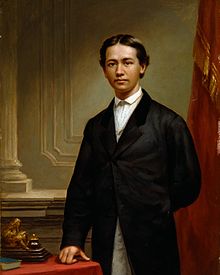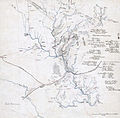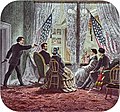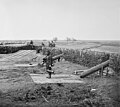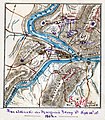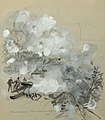Portal:American Civil War
 |
 |

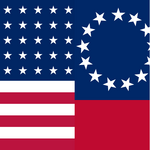
The American Civil War (1861–1865) was a sectional rebellion against the United States of America by the Confederate States, formed of eleven southern states' governments which moved to secede from the Union after the 1860 election of Abraham Lincoln as President of the United States. The Union's victory was eventually achieved by leveraging advantages in population, manufacturing and logistics and through a strategic naval blockade denying the Confederacy access to the world's markets.
In many ways, the conflict's central issues – the enslavement of African Americans, the role of constitutional federal government, and the rights of states – are still not completely resolved. Not surprisingly, the Confederate army's surrender at Appomattox on April 9,1865 did little to change many Americans' attitudes toward the potential powers of central government. The passage of the Thirteenth, Fourteenth and Fifteenth amendments to the Constitution in the years immediately following the war did not change the racial prejudice prevalent among Americans of the day; and the process of Reconstruction did not heal the deeply personal wounds inflicted by four brutal years of war and more than 970,000 casualties – 3 percent of the population, including approximately 560,000 deaths. As a result, controversies affected by the war's unresolved social, political, economic and racial tensions continue to shape contemporary American thought. The causes of the war, the reasons for the outcome, and even the name of the war itself are subjects of much discussion even today. (Full article)
CSS Missouri was a casemate ironclad built by the Confederate States Navy during the American Civil War. Her propulsion machinery was taken from an existing steamboat, her armor was railroad T-rails, and she was armed with three captured cannon. She was difficult to steer and leaked badly. Additional equipment had to be added to allow her to reach her intended speed. Completed during 1863 on the Red River, she was trapped in the Shreveport, Louisiana, area by low water and never saw combat. The vessel's crew had desertion issues and some of her crewmen were pulled from the army. After traveling downriver for the first time, the ship was surrendered in June 1865 to the United States Navy—the last Confederate ironclad to be handed over—and sold in November. (Full article...)

At the outbreak of the American Civil War, Oregon raised the 1st Oregon Cavalry that was activated in 1862 and served until June 1865. During the Civil War, emigrants to the newfound gold fields in Idaho and Oregon continued to clash with the Paiute, Shoshone and Bannock tribes of Oregon, Idaho and Nevada until relations degenerated into the bloody 1864–1868 Snake War. The 1st Oregon Volunteer Infantry Regiment was formed in 1864 and its last company was mustered out of service in July 1867. Both units were used to guard travel routes and Indian reservations, escort emigrant wagon trains, and protect settlers from Indian raiders. Several infantry detachments also accompanied survey parties and built roads in central and southern Oregon.
Oregon's second United States Senator, Col. Edward Dickinson Baker was killed while leading Union troops at the Battle of Ball's Bluff near Leesburg, Virginia on October 21, 1861. His death in battle occurred exactly one month after another Oregonian, Captain James W. Lingenfelter of Company B, 71st Pennsylvania Infantry Regiment, was killed while on the picket line. In civilian life, Captain Lingenfelter had been a practicing attorney in Jacksonville, Oregon. He had been visiting in the East when the war started and enlisted to serve with Colonel Baker. (Full article...)
Timothy Henry Hoʻolulu Pitman (March 18, 1845 – February 27, 1863) was an American Union Army soldier of Native Hawaiian descent. Considered one of the "Hawaiʻi Sons of the Civil War", he was among a group of more than one hundred documented Native Hawaiian and Hawaii-born combatants who fought in the American Civil War while the Kingdom of Hawaiʻi was still an independent nation.
Born and raised in Hilo, Hawaiʻi, he was the eldest son of Kinoʻoleoliliha, a Hawaiian high chiefess, and Benjamin Pitman, an American pioneer settler from Massachusetts. Through his father's business success in the whaling and sugar and coffee plantation industries and his mother's familial connections to the Hawaiian royal family, the Pitmans were quite prosperous and owned lands on the island of Hawaiʻi and in Honolulu. He and his older sister Mary were educated in the mission schools in Hilo alongside other children of mixed Hawaiian descent. After the death of his mother in 1855, his father remarried to the widow of a missionary, thus connecting the family to the American missionary community in Hawaiʻi. However, following the deaths of his first wife and later his second wife, his father decided to leave the islands and returned to Massachusetts with his family in 1861. The younger Pitman continued his education in the public schools of Roxbury, where the Pitman family lived for a period of time. (Full article...)
- ... that Justus H. Rathbone, founder of the Knights of Pythias, served as a hospital steward during the American Civil War?
- ... that Colonel Bradley Winslow was brevetted by US president Abraham Lincoln for "brave and gallant conduct" during the siege of Petersburg in the American Civil War?
- ... that CSS Beaufort fought USS Albatross in the first ship-versus-ship action of the American Civil War?
- ... that some historians believe that Steele's Greenville expedition marked a shift in the Union's war policy?
- ... that Francis Orray Ticknor was a country doctor whose fame as a poet relies on "Little Giffen", a poem about one of his patients who died in the American Civil War?
- ... that according to one historian, James S. Rains made a "significant contribution to the Confederate war effort" by getting drunk?
- Attention needed
- ...to referencing and citation • ...to coverage and accuracy • ...to structure • ...to grammar • ...to supporting materials
- Popular pages
- Full list
- Cleanup needed
- The West Tennessee Raids
- Requested articles
- James Ashby (soldier) • Bluffton expedition • Benjamin D. Fearing • Charles A. Hickman • Richard Henry Jackson • James B. Speers • Charles S. Steedman • Battle of Barton's Station • Lawrence P. Graham • Thomas John Lucas • Daniel Henry Rucker • James Hughes Stokes • Frederick S. Sturmbaugh • Davis Tillson • Action at Nineveh (currently a redirect) • International response to the American Civil War • Spain and the American Civil War • Savannah Campaign Confederate order of battle • Native Americans in the American Civil War (currently disambiguation after deletion) • 1st Battalion, Mississippi Mounted Rifles (Union) • Battle of Lafayette • Requested American Civil War Medal of Honor recipients
- Expansion needed
- Battle of Boonsborough • Battle of Guard Hill • Battle of Rice's Station • Battle of Simmon's Bluff • Battle of Summit Point • Charleston Arsenal • Edenton Bell Battery • First Battle of Dalton • Blackshear Prison • Edwin Forbes • Hiram B. Granbury • Henry Thomas Harrison • Louis Hébert (colonel) • Benjamin G. Humphreys • Maynard Carbine • Hezekiah G. Spruill • Smith carbine • Edward C. Walthall • Confederate States Secretary of the Navy • Confederate States Secretary of the Treasury • David Henry Williams • Battle of Rome Cross Roads • Delaware in the American Civil War • Ironclad Board • United States Military Railroad • Kansas in the American Civil War • Rufus Daggett • Ebenezer Magoffin • Confederate Quartermaster-General's Department • First Corps, Army of Northern Virginia • Francis Laurens Vinton • Henry Maury • Smith's Expedition to Tupelo • Other American Civil War battle stubs • Other American Civil War stubs
- Images needed
- Battle of Lone Jack • Preston Pond, Jr. • Melancthon Smith
- Merging needed
- 1st Regiment New York Mounted Rifles and 7th Regiment New York Volunteer Cavalry
- Citations needed
- 1st Alabama Cavalry Regiment (Union) • 4th Maine Battery • 33rd Ohio Infantry • 110th New York Volunteer Infantry • Battle of Hatcher's Run • Camp Dennison • Confederate colonies • CSS Resolute • Dakota War of 1862 • Florida in the American Civil War • Ethan A. Hitchcock (general) • Fort Harker (Alabama) • Gettysburg (1993 film) • Iowa in the American Civil War • Second Battle of Fort Sumter • Samuel Benton
- Translation needed
- Add an article here!
The following Wikimedia Foundation sister projects provide more on this subject:
-
Commons
Free media repository -
Wikibooks
Free textbooks and manuals -
Wikidata
Free knowledge base -
Wikinews
Free-content news -
Wikiquote
Collection of quotations -
Wikisource
Free-content library -
Wikiversity
Free learning tools -
Wikivoyage
Free travel guide -
Wiktionary
Dictionary and thesaurus
- Shortcuts to this page: Portal:ACW • P:ACW
- Manually maintained portal pages from December 2018
- All manually maintained portal pages
- Portals with triaged subpages from December 2018
- All portals with triaged subpages
- All portals
- Portals with named maintainer
- American Civil War portal
- Military and war-related portals
- United States portals
- American Civil War
- Unredirected portals with existing subpages
- History portals

